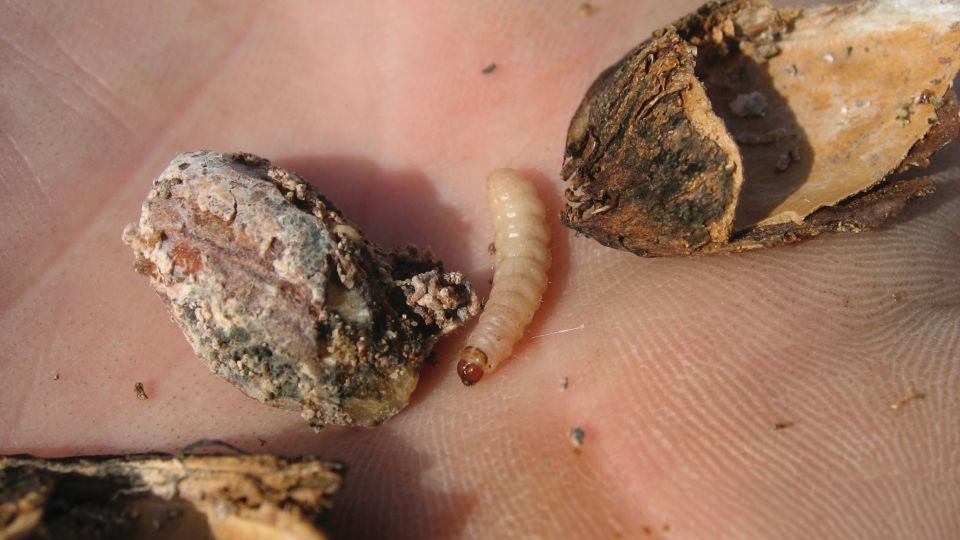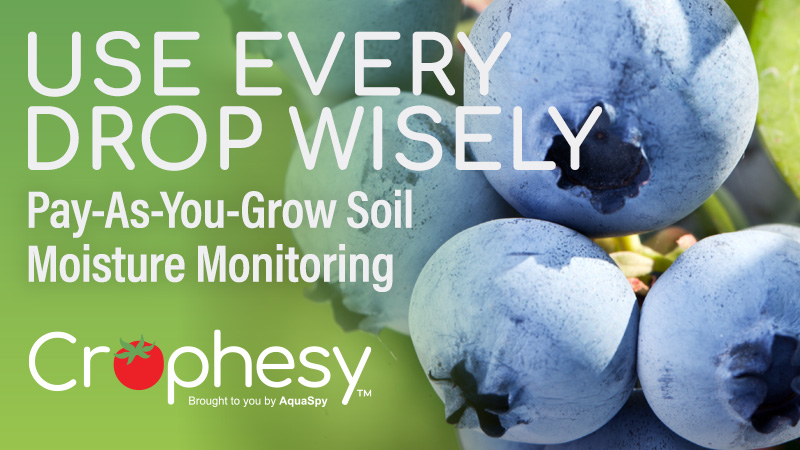Tackling the No. 1 Enemy for Almonds — Navel Orangeworm

Navel orangeworm larvae is shown from a mummy cracked open in January. (Photo: Franz Niederholzer)
Having worked as the University of California Cooperative Extension (UCCE) Area Integrated Pest Management Advisor in the nut-rich North San Joaquin Valley for several years, Jhalendra Rijal has long studied the most damaging pest in both almonds and pistachios.
Navel orangeworm (NOW) is often on the minds of almond growers, so he provides an overview of the pest heading into the 2023 growing season. First the good news: Growers are coming off a good year, generally having it pretty easy in 2022 relative to past years.
“For NOW, 2022 was not bad in terms of overall damage across all nut crops in the (Central) Valley,” he says. “We saw generally moderate to low levels.”
However, Rijal does not expect such levels in the coming years. Because of global warming, the environment will become increasingly suitable for building NOW populations. Currently, growers see up to four generations of the pest in a single season, but a major change is expected in the coming years of warmer winters.
“We will see a fifth generation in the southern part of the (San Joaquin) Valley as early as 2040,” he says. “That’s not that long a time if you think of an entire extra generation.”
In other words, there is no time like the present for growers to look at ways to improve their NOW IPM programs, Rijal says. While growers will likely have increasing numbers of the menacing pests to deal with, the keys to prevent damage are in their hands.
SHAKE ’EM, BABY, SHAKE ’EM
IPM means employing multiple tactics, Rijal says. Monitoring is critical. Various attractant traps focus on either males or females, as tracking flights throughout the season will allow you to control your insecticides.
However, insecticides are not the key to controlling NOW, Rijal emphasizes. There is no substitute for mummy sanitation, as that has proven time and again to be the most effective control of NOW. Mummies should be removed from trees before Feb. 1 — well before bloom — and all the nuts should be flail-mowed prior to March 15.
He cites a chart produced by a team led by former chief of UCCE IPM Frank Zalom back in the 1980s that still proves true today. With sanitation only, researchers found an average of 0.87 mummies per tree led to nut damage levels of about 2%. Without sanitation, trees that averaged 28.1 mummies, and an insecticide application produced more than twice the almond damage — about 5%.
“We need to hammer on the importance of mummy sanitation every year,” Rijal says.
One important note on shaking mummies that Rijal has noticed during the state’s drought that blessedly wasn’t a factor this year: Some years it’s too dry for mummy sanitation, as shake is much more effective with a little moisture. If it’s a dry year, he says if there’s a rainstorm anytime between harvest and February, go in afterwards as soon as the ground firms up, as it’s a great time to shake.
One potentially overlooked strategy to prevent NOW damage is to harvest before the pests arrive through careful trap monitoring. Rijal says growers may be able to harvest prior to the arrival of the pest’s third flight, usually in late August.
“If you can harvest before then, the moths can’t lay eggs on the fruit. Even waiting three days makes a difference,” he says. “If you can harvest just three days early, you might avoid a whole lot of NOW activity on those nuts.”
CUT NAVEL ORANGEWORM POPULATIONS
The most promising method of limiting damage going forward is mating disruption (MD), which can generally limit populations by 45% to 50%. Rijal says there are numerous reasons for implementing MD — which has already been adopted on thousands of acres — including the key advantage that without pesticides, there is no REI, PHI, or MRL concerns. With the cost per acre less than $100, Rijal says it’s not only affordable, but growers can support the industry goal of sustainable pest management.
Growers interested in MD should contact the Almond Board of California (ABC) for details on a new program to address the problem that smaller growers don’t participate in MD because the benefits aren’t fully realized on blocks of fewer than 40 acres. The ABC pursued a grant through the Department of Pesticide Regulation to encourage small growers to voluntarily work together to create larger blocks of orchards, across a variety of tree nut crops, to manage NOW.
Working together with Land IQ, Blue Diamond Growers, and UCCE, ABC has developed an online web mapping application that allows Pest Control Advisers and growers to identify their orchards and indicate whether or not they already implement MD or have an interest in participating in a neighborhood management program.









